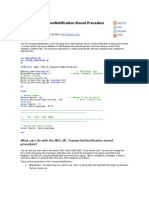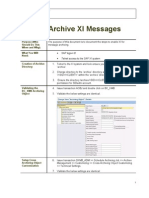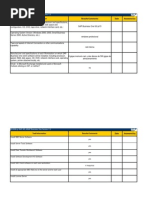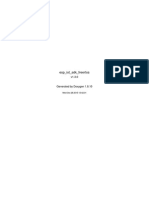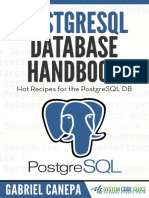Using The SBO - SP - TransactionNotification Stored Procedure
Uploaded by
krlamevUsing The SBO - SP - TransactionNotification Stored Procedure
Uploaded by
krlamevUsing the
SBO_SP_TransactionNotification
Stored Procedure
Applies to:
SAP Business One, SDK, SBO_SP_TransactionNotification stored procedure
Summary
This article explains how to use the SBO_SP_TransactionNotification stored procedure to receive notification
of a data-driven event in SAP® Business One. You can also download the code samples.
Author: James Kofalt
Company: SAP
Created on: March 2004
Last update: May 2009 by SAP B1 Solution Architects
SAP COMMUNITY NETWORK SDN - sdn.sap.com | BPX - bpx.sap.com | BOC - boc.sap.com
© 2009 SAP AG 1
Using the SBO_SP_TransactionNotification Stored Procedure
Table of Contents
Motivation............................................................................................................................................................3
The SBO_SP_TransactionNotification in detail ..................................................................................................3
Important Note for 2007 version .....................................................................................................................5
Adding Code to the Stored Procedure................................................................................................................5
Related Contents ................................................................................................................................................6
Copyright.............................................................................................................................................................7
SAP COMMUNITY NETWORK SDN - sdn.sap.com | BPX - bpx.sap.com | BOC - boc.sap.com
© 2009 SAP AG 2
Using the SBO_SP_TransactionNotification Stored Procedure
Motivation
Partners frequently ask me whether there is a way to receive notification of a data-driven event in SAP
Business One. In other words, developers need a way to trigger events in their application based on
something that happens in SAP Business One. For events that occur within the SAP Business One client
application, it is as simple as using the User Interface API (UI-API) to trap events and respond to them.
However, for events where the client application is not involved, for example when someone inserts a
document through the Data Interface API (DI-API), another mechanism is required.
The mechanism for receiving notification of data-driven events is then to locate some code inside the existing
B1 stored procedure called SBO_SP_TransactionNotification.
Please note that adding SQL triggers or Stored Procedures at the database level is not permitted (cf. SAP
Business One Add-On Solution Certification document) – in addition triggers will be automatically removed
during the SAP Business One upgrade process when the corresponding table is modified.
The SBO_SP_TransactionNotification in detail
SAP Business One provides the SBO_SP_TransactionNotification stored procedure mechanism for receiving
notification of data-driven events. This stored procedure is fired whenever operations are performed on
business objects like document or master records in SAP Business One. This applies not only to objects
already exposed through DI API, but to any business object in the application – including User-Defined
Objects (UDO). By adding your own Transact-SQL code, you can pass parameters to your application and
retrieve the corresponding objects from SAP Business One.
The SBO_SP_TransactionNotification stored procedure is created automatically when you create a new
company in SAP Business One. It is missing from some of the SAP Business One demo databases (for
example the US demo database), but you can easily add it manually using SQL Enterprise Manager or SQL
Query Analyzer. When it is initially created, it looks like this:
CREATE proc SBO_SP_TransactionNotification
@object_type nvarchar(20), -- SBO Object Type
@transaction_type nchar(1), -- [A]dd, [U]pdate, [D]elete, [C]ancel, C[L]ose
@num_of_cols_in_key int,
@list_of_key_cols_tab_del nvarchar(255),
@list_of_cols_val_tab_del nvarchar(255)
AS
begin
-- Return values
declare @error int -- Result (0 for no error)
declare @error_message nvarchar (200) -- Error string to be displayed
select @error = 0
select @error_message = N'Ok'
------------------------------------------------------------
-- ADD YOUR CODE HERE
-------------------------------------------------------------
-- Select the return values
select @error, @error_message
end
GO
SAP COMMUNITY NETWORK SDN - sdn.sap.com | BPX - bpx.sap.com | BOC - boc.sap.com
© 2009 SAP AG 3
Using the SBO_SP_TransactionNotification Stored Procedure
There are five out parameters:
Parameter Example
@objecttype 2 (Business Partner) Since version 2005 it returns a string
representing the type of object – used to be a
numerical value in previous versions.
A full list of object types exposed through DI
API can be found in the DI API documentation
under the section Enumerations. The
enumeration is called BoObjectTypes.
@transaction_type U (update) It may have values of:
A (where a record was added)
U (where a record was updated)
D (where a record was deleted),
C (where a document was canceled)
L (where a document was closed)
@num_of_cols_in_key 1 Returns the number of columns or fields in the
key to the record.
A Business Partner, for example, has a key
consisting of a single field (CardCode), so this
variable would have a value of "1". A Special
Prices object, however, has a key consisting
of the CardCode and ItemCode, so for a
Special Prices object this variable would have
a value of "2".
@list_of_key_cols_tab_del CardCode It returns a tab-delimited list of column names
(field names) that represent the object key.
For a Business Partner, this would be
"CardCode". For a Special Prices object, it
would be "CardCode ItemCode".
@list_of_cols_val_tab_del C40001 This returns a tab-delimited list of values
required to retrieve the object from Business
One.
For example, a Business Partner record might
have a value of "C40001". A Special Prices
object would contain 2 fields separated by a
tab character. For example: "V10005 ...
A00001"
SAP COMMUNITY NETWORK SDN - sdn.sap.com | BPX - bpx.sap.com | BOC - boc.sap.com
© 2009 SAP AG 4
Using the SBO_SP_TransactionNotification Stored Procedure
Important Note for 2007 version
With the release of SAP Business One 2007, Business One will wait for the
SBO_SP_TransactionNotification stored procedure to return both parameters @error and
@error_message as return values. Without the return of these values, SAP Business One will consider the
transaction as failed.
If you are placing code in the SBO_SP_TransactionNotification, please make sure you always go through the
“select @error, @error_message” line at the end, especially in the case where you want the
transaction to be considered as successful.
Adding Code to the Stored Procedure
Now that you are familiar with the values returned by the SBO_SP_TransactionNotification stored
procedure, let's take a look at a sample code that uses it.
The sample that accompanies this article includes a simple Visual Basic 6 project called "DisplaySBOInfo".
You should use REGSVR32.EXE to register the compiled dll that is included. DisplaySBOInfo exposes a
single method called DisplaySBOInfo. This method takes the information provided by
SBO_SP_TransactionNotification as parameters and writes them to a tab-delimited text file called
Log.txt. The SBO_SP_TransactionNotification stored procedure should be modified to include the
following Transact-SQL code. Add the following text to the section of the stored procedure that says "Add
Your Code Here":
DECLARE @object int --declare the object variable
DECLARE @hresult int --declare the hresult variable
DECLARE @retval float --declare the return variable
EXEC @hresult = sp_OACreate 'DisplaySBOInfo.Class1', @object OUT
EXEC @hresult = sp_OAMethod @object, DisplaySBOInfo, @retval OUT, @object_type,
@transaction_type, @num_of_cols_in_key, @list_of_key_cols_tab_del,
@list_of_cols_val_tab_del
IF @hresult <> 0
BEGIN
EXEC sp_OAGetErrorInfo @object
RETURN
END
This creates an instance of DisplaySBOInfo.Class1 and calls the DisplaySBOInfo method, passing
parameters to it that will be written to the text log.
After you have added your code to the stored procedure, open up SAP Business One and make a few
changes. For example, add a Business Partner, edit a Quotation, and then delete the Business Partner.
When you're done, open Log.txt and take a look at the data. In a real-life scenario, you would use the
information provided by SBO_SP_TransactionNotification with the DI-API to retrieve more information
about the record that was inserted, deleted, or changed.
When you are done with this sample exercise, go back to the stored procedure and delete or comment out
the code that was added. This will insure that the sample does not continue to run.
If you would like, you can download the sample code that was described in this article.
You can also download SAP Business One DI Event Service sample implementing a DI Event Service that
runs on top of the existing SAP Business One SDK interfaces. This service provides notifications on events
related to SAP Business One DI API objects through a listener-based interface.
SAP COMMUNITY NETWORK SDN - sdn.sap.com | BPX - bpx.sap.com | BOC - boc.sap.com
© 2009 SAP AG 5
Using the SBO_SP_TransactionNotification Stored Procedure
Related Contents
For more information, visit the Business One homepage.
SAP COMMUNITY NETWORK SDN - sdn.sap.com | BPX - bpx.sap.com | BOC - boc.sap.com
© 2009 SAP AG 6
Using the SBO_SP_TransactionNotification Stored Procedure
Copyright
© Copyright 2009 SAP AG. All rights reserved.
No part of this publication may be reproduced or transmitted in any form or for any purpose without the express permission of SAP AG.
The information contained herein may be changed without prior notice.
Some software products marketed by SAP AG and its distributors contain proprietary software components of other software vendors.
Microsoft, Windows, Excel, Outlook, and PowerPoint are registered trademarks of Microsoft Corporation.
IBM, DB2, DB2 Universal Database, System i, System i5, System p, System p5, System x, System z, System z10, System z9, z10, z9,
iSeries, pSeries, xSeries, zSeries, eServer, z/VM, z/OS, i5/OS, S/390, OS/390, OS/400, AS/400, S/390 Parallel Enterprise Server,
PowerVM, Power Architecture, POWER6+, POWER6, POWER5+, POWER5, POWER, OpenPower, PowerPC, BatchPipes,
BladeCenter, System Storage, GPFS, HACMP, RETAIN, DB2 Connect, RACF, Redbooks, OS/2, Parallel Sysplex, MVS/ESA, AIX,
Intelligent Miner, WebSphere, Netfinity, Tivoli and Informix are trademarks or registered trademarks of IBM Corporation.
Linux is the registered trademark of Linus Torvalds in the U.S. and other countries.
Adobe, the Adobe logo, Acrobat, PostScript, and Reader are either trademarks or registered trademarks of Adobe Systems
Incorporated in the United States and/or other countries.
Oracle is a registered trademark of Oracle Corporation.
UNIX, X/Open, OSF/1, and Motif are registered trademarks of the Open Group.
Citrix, ICA, Program Neighborhood, MetaFrame, WinFrame, VideoFrame, and MultiWin are trademarks or registered trademarks of
Citrix Systems, Inc.
HTML, XML, XHTML and W3C are trademarks or registered trademarks of W3C®, World Wide Web Consortium, Massachusetts
Institute of Technology.
Java is a registered trademark of Sun Microsystems, Inc.
JavaScript is a registered trademark of Sun Microsystems, Inc., used under license for technology invented and implemented by
Netscape.
SAP, R/3, SAP NetWeaver, Duet, PartnerEdge, ByDesign, SAP Business ByDesign, and other SAP products and services mentioned
herein as well as their respective logos are trademarks or registered trademarks of SAP AG in Germany and other countries.
Business Objects and the Business Objects logo, BusinessObjects, Crystal Reports, Crystal Decisions, Web Intelligence, Xcelsius, and
other Business Objects products and services mentioned herein as well as their respective logos are trademarks or registered
trademarks of Business Objects S.A. in the United States and in other countries. Business Objects is an SAP company.
All other product and service names mentioned are the trademarks of their respective companies. Data contained in this document
serves informational purposes only. National product specifications may vary.
These materials are subject to change without notice. These materials are provided by SAP AG and its affiliated companies ("SAP
Group") for informational purposes only, without representation or warranty of any kind, and SAP Group shall not be liable for errors or
omissions with respect to the materials. The only warranties for SAP Group products and services are those that are set forth in the
express warranty statements accompanying such products and services, if any. Nothing herein should be construed as constituting an
additional warranty.
SAP COMMUNITY NETWORK SDN - sdn.sap.com | BPX - bpx.sap.com | BOC - boc.sap.com
© 2009 SAP AG 7
You might also like
- Implementing Budgeting For Microsoft Dynamics AX 2012 Applications AX 2012No ratings yetImplementing Budgeting For Microsoft Dynamics AX 2012 Applications AX 201214 pages
- SAP-Learning-Hub-General-User-Guide Jan 15 36482 GB 33437 CompressedNo ratings yetSAP-Learning-Hub-General-User-Guide Jan 15 36482 GB 33437 Compressed6 pages
- SAP Note 2079411 - Troubleshooting Guide To Analyse User Customizations in A Company DatabaseNo ratings yetSAP Note 2079411 - Troubleshooting Guide To Analyse User Customizations in A Company Database8 pages
- A Step by Step Guide For Beginners On User Defined BAPI Creation - ABAP DevelopmentNo ratings yetA Step by Step Guide For Beginners On User Defined BAPI Creation - ABAP Development15 pages
- Enabling - SAP B1 - Tips and Tricks SAP - January 2012No ratings yetEnabling - SAP B1 - Tips and Tricks SAP - January 201211 pages
- SAP Customer Checkout B1if Scenario Extension V - 2.0No ratings yetSAP Customer Checkout B1if Scenario Extension V - 2.025 pages
- Task/Information Results/Comments Date Answered By: © 2006 by SAP AG, ASAP Business One Version 1.0No ratings yetTask/Information Results/Comments Date Answered By: © 2006 by SAP AG, ASAP Business One Version 1.017 pages
- SAP B1 General Settings For Ivend RetailNo ratings yetSAP B1 General Settings For Ivend Retail12 pages
- Content Model For SAP Records Management PDFNo ratings yetContent Model For SAP Records Management PDF11 pages
- SAP Service and Asset Manager Configuration GuideNo ratings yetSAP Service and Asset Manager Configuration Guide134 pages
- License Comparison Chart For SAP Business OneNo ratings yetLicense Comparison Chart For SAP Business One6 pages
- Change Documents Maintanence For ZTABLES in CDPOS & CDHDRNo ratings yetChange Documents Maintanence For ZTABLES in CDPOS & CDHDR10 pages
- ABAP Development - Displaying A DMS PDF Document..in WD100% (1)ABAP Development - Displaying A DMS PDF Document..in WD3 pages
- Steps To Setup N-Step Workflow Approval - Brief StepsNo ratings yetSteps To Setup N-Step Workflow Approval - Brief Steps4 pages
- Why SAP BPC NW On Sap Hana Is The Right ChoiceNo ratings yetWhy SAP BPC NW On Sap Hana Is The Right Choice5 pages
- Integration Guide Feature Delivery PRODNo ratings yetIntegration Guide Feature Delivery PROD386 pages
- Business Application Programming Interface BAPI Standard RequirementsFrom EverandBusiness Application Programming Interface BAPI Standard RequirementsNo ratings yet
- Instant Access to C programming from problem analysis to program design 4th ed Edition D S Malik ebook Full Chapters100% (8)Instant Access to C programming from problem analysis to program design 4th ed Edition D S Malik ebook Full Chapters82 pages
- A Qualitative Study of Major Programming Languages: Teaching Programming Languages To Computer Science StudentsNo ratings yetA Qualitative Study of Major Programming Languages: Teaching Programming Languages To Computer Science Students12 pages
- EMCO Network Inventory Professional ManualNo ratings yetEMCO Network Inventory Professional Manual121 pages
- What Is Object Oriented Programming? How It Is Differ From Procedure Oriented Programming?No ratings yetWhat Is Object Oriented Programming? How It Is Differ From Procedure Oriented Programming?18 pages
- SecurityProtocolType Enum (System - Net) - Microsoft DocsNo ratings yetSecurityProtocolType Enum (System - Net) - Microsoft Docs3 pages
- 20B-ESP8266 - RTOS - SDK - API Reference - v1.3.0No ratings yet20B-ESP8266 - RTOS - SDK - API Reference - v1.3.0176 pages
- Salesforce Development: Learn WI TH S2 Labs100% (1)Salesforce Development: Learn WI TH S2 Labs106 pages
- Just A Brief Introduction To C++ Data Types PDFNo ratings yetJust A Brief Introduction To C++ Data Types PDF4 pages
- Implementing Budgeting For Microsoft Dynamics AX 2012 Applications AX 2012Implementing Budgeting For Microsoft Dynamics AX 2012 Applications AX 2012
- SAP-Learning-Hub-General-User-Guide Jan 15 36482 GB 33437 CompressedSAP-Learning-Hub-General-User-Guide Jan 15 36482 GB 33437 Compressed
- SAP Note 2079411 - Troubleshooting Guide To Analyse User Customizations in A Company DatabaseSAP Note 2079411 - Troubleshooting Guide To Analyse User Customizations in A Company Database
- A Step by Step Guide For Beginners On User Defined BAPI Creation - ABAP DevelopmentA Step by Step Guide For Beginners On User Defined BAPI Creation - ABAP Development
- Enabling - SAP B1 - Tips and Tricks SAP - January 2012Enabling - SAP B1 - Tips and Tricks SAP - January 2012
- SAP Customer Checkout B1if Scenario Extension V - 2.0SAP Customer Checkout B1if Scenario Extension V - 2.0
- Task/Information Results/Comments Date Answered By: © 2006 by SAP AG, ASAP Business One Version 1.0Task/Information Results/Comments Date Answered By: © 2006 by SAP AG, ASAP Business One Version 1.0
- Change Documents Maintanence For ZTABLES in CDPOS & CDHDRChange Documents Maintanence For ZTABLES in CDPOS & CDHDR
- ABAP Development - Displaying A DMS PDF Document..in WDABAP Development - Displaying A DMS PDF Document..in WD
- Steps To Setup N-Step Workflow Approval - Brief StepsSteps To Setup N-Step Workflow Approval - Brief Steps
- SAP NetWeaver Portal A Clear and Concise ReferenceFrom EverandSAP NetWeaver Portal A Clear and Concise Reference
- Business Application Programming Interface BAPI Standard RequirementsFrom EverandBusiness Application Programming Interface BAPI Standard Requirements
- Instant Access to C programming from problem analysis to program design 4th ed Edition D S Malik ebook Full ChaptersInstant Access to C programming from problem analysis to program design 4th ed Edition D S Malik ebook Full Chapters
- A Qualitative Study of Major Programming Languages: Teaching Programming Languages To Computer Science StudentsA Qualitative Study of Major Programming Languages: Teaching Programming Languages To Computer Science Students
- What Is Object Oriented Programming? How It Is Differ From Procedure Oriented Programming?What Is Object Oriented Programming? How It Is Differ From Procedure Oriented Programming?
- SecurityProtocolType Enum (System - Net) - Microsoft DocsSecurityProtocolType Enum (System - Net) - Microsoft Docs

